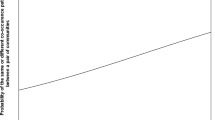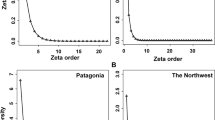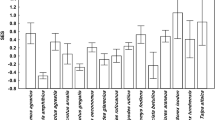Abstract
Biological communities may be assembled by both niche-based and dispersal-based (= historic) processes with the relative importance of these processes in community assembly being scale- and context-dependent. To infer whether (a) niche‐based or dispersal‐based processes play the main role in the assembly of flea communities parasitic on small mammals and whether (b) the main processes of flea community assembly are scale-dependent, we applied a novel permutation-based algorithm (PER-SIMPER) and the dispersal–niche continuum index (DNCI), to data on the species incidence of fleas and their hosts at two spatial scales. At the larger (continental) scale, we analysed flea communities in four biogeographic realms across adjacent continental sections. At the smaller (local) scale, we considered flea communities across two main regions (lowlands and mountains) and seven habitat types within Slovakia. Our analyses demonstrated that species composition of fleas and their small mammalian hosts depended predominantly on historical processes (dispersal) at both scale. This was true for the majority of biogeographic realms at continental scale (except the Nearctic) and both regions at local scale. Nevertheless, strong niche-based assembly mechanism was found in the Nearctic assemblages. At local scale, the intensity of dispersal processes was weaker and niche-driven processes were stronger between habitats within a region than between mountain and lowland regions. We provide historical and ecological explanations for these patterns. We conclude that the assembly of compound flea communities is governed, to a great extent, by the dispersal processes acting on their hosts and, to a lesser extent, by the niche-based processes.



Similar content being viewed by others
References
Ackerly DD, Cornwell WK (2007) A trait-based approach to community assembly: partitioning of species trait values into within- and among-community components. Ecol Lett 10:135–145. https://doi.org/10.1111/j.1461-0248.2006.01006.x
Araújo MB, Rozenfeld A (2014) The geographic scaling of biotic interactions. Ecography 37:406–415. https://doi.org/10.1111/j.1600-0587.2013.00643.x
Bar-Massada A, Kent R, Carmel Y (2014) Environmental heterogeneity affects the location of modelled communities along the niche–neutrality continuum. Proc Roy Soc Lond B 281:20133249. https://doi.org/10.1098/rspb.2013.3249
Cain ML, Damman H, Muir A (1998) Seed dispersal and the Holocene migration of woodland herbs. Ecol Monogr 68:325–347. https://doi.org/10.1890/0012-9615(1998)068[0325:SDATHM]2.0.CO;2
Cardillo M (2015) Geographic range shifts do not erase the historic signal of speciation in mammals. Am Nat 185:343–353. https://doi.org/10.1086/679663
Chase JM, Myers JA (2011) Disentangling the importance of ecological niches from stochastic processes across scales. Phil Trans Roy Soc Lond B 366:2351–2363. https://doi.org/10.1098/rstb.2011.0063
Chesson P (2000) Mechanisms of maintenance of species diversity. Ann Rev Ecol Syst 31:343–366. https://doi.org/10.1146/annurev.ecolsys.31.1.343
Clarke KR (1993) Non-parametric multivariate analyses of changes in community structure. Austral J Ecol 18:117–143. https://doi.org/10.1111/j.1442-9993.1993.tb00438.x
Clarke JA, Johnson RE (1990) Biogeography of white-tailed ptarmigan (Lagopus leucurus): implications from an introduced population in the Sierra Nevada. J Biogeogr 17:649–656. https://doi.org/10.2307/2845146
Colwell RK, Winkler DW (1984) A null model for null models in biogeography. In: Strong DR, Simberloff DS, Abele LG, Thistle AB (eds) Ecological communities: conceptual issues and the evidence. Princeton Univ Press, Princeton, pp 344–359
Connor EF, Simberloff D (1979) The assembly of species communities: chance or competition. Ecology 60:1132–1140. https://doi.org/10.2307/1936961
Cook JA, MacDonald SO (2001) Should endemism be a focus of conservation efforts along the North Pacific Coast of North America? Biol Cons 97:207–213. https://doi.org/10.1016/S0006-3207(00)00113-0
Cornell HV, Harrison SP (2014) What are species pools and when are they important? Ann Rev Ecol Evol Syst 45:45–67. https://doi.org/10.1146/annurev-ecolsys-120213-091759
Day JF, Benton AH (1980) Population dynamics and coevolution of adult siphonapteran parasites of the southern flying squirrel (Glaucomys volans volans). Am Midl Nat 103:333–338
Diamond JM (1975) Assembly of species communities. In: Cody ML, Diamond JM (eds) Ecology and evolution of communities. Harvard Univ Press, Cambridge, pp 342–444
Dove ADM (2006) Defining parasite communities is a challenge for neutral theory. J Parasitol 92:673–675. https://doi.org/10.1645/GE-677R.1
Fisher CK, Mehta P (2014) The transition between the niche and neutral regimes in ecology. Proc Natl Acad Sci USA 111:13111–13116. https://doi.org/10.1073/pnas.1405637111
Gibert C, Escarguel G (2019) PER-SIMPER—a new tool for inferring community assembly processes from taxon occurrences. Glob Ecol Biogeogr 28:374–385. https://doi.org/10.1111/geb.12859
Gibert C, Escarguel G, Vilmi A, Wang J (2020) DNCImper: assembly process identification based on SIMPER analysis. R package ver. 0.0.1.0000. https://github.com/Corentin-Gibert-Paleontology/DNCImper
Gotelli NJ, Graves GR (1996) Null models in ecology. Smithsonian Inst Press, Washington
Gotelli N, Rohde K (2002) Co-occurrence of ectoparasites of marine fishes: a null model analysis. Ecol Lett 5:86–94. https://doi.org/10.1046/j.1461-0248.2002.00288.x
Goudarzi F, Hemami M-R, Rancilhac L, Malekian M, Fakheran S, Elmer KR, Steinfartz S (2019) Geographic separation and genetic differentiation of populations are not coupled with niche differentiation in threatened Kaiser’s spotted newt (Neurergus kaiseri). Sci Rep 9:6239. https://doi.org/10.1038/s41598-019-41886-8
Gravel D, Canham CD, Beaudet M, Messier C (2006) Reconciling niche and neutrality: the continuum hypothesis. Ecol Lett 9:399–409. https://doi.org/10.1111/j.1461-0248.2006.00884.x
Gutiérrez PA, Matorelli SR (1999) Niche preferences and spatial distribution of Monogenea on the gills of Pimelodus maculatus in Río de la Plata (Argentina). Parasitology 119:183–188. https://doi.org/10.1017/s003118209900459x
Haukisalmi V, Henttonen H (1993) Coexistence in helminths of the bank vole Clethrionomys glareolus. I. Patterns of co-occurrence. J Anim Ecol 62:221–229. https://doi.org/10.2307/5353
Holmes JC, Price PW (1986) Communities of parasites. In: Kittawa J, Anderson DJ (eds) Community ecology: pattern and process. Blackwell, Oxford, pp 187–213
Hubbell SP (2001) The unified neutral theory of biodiversity and biogeography. Princeton Univ Press, Princeton
Hubbell SP (2006) Neutral theory and the evolution of ecological equivalence. Ecology 87:1387–1398. https://doi.org/10.1890/0012-9658
Hutchinson GE (1957) A treatise on limnology, vol II. John Wiley, NY
Hutchinson GE (1959) Homage to Santa Rosalia, or why are there so many kinds of animals? Am Nat 93:145–159. https://doi.org/10.1086/282070
Ingram T, Shurin JB (2009) Trait-based assembly and phylogenetic structure in northeast Pacific rockfish assemblages. Ecology 90:2444–2453. https://doi.org/10.1890/08-1841.1
Kembel SW, Hubbell SP (2006) The phylogenetic structure of a neotropical forest tree community. Ecology 87:S86–S99. https://doi.org/10.1890/0012-9658(2006)87[86:TPSOAN]2.0.CO;2
Khokhlova IS, Dlugosz EM, Krasnov BR (2016) Experimental evidence of negative interspecific interactions among imago fleas: flea and host identities matter. Parasitol Res 115:937–947. https://doi.org/10.1007/s00436-015-4818-z
Kraft NJB, Ackerly DD (2010) Functional trait and phylogenetic tests of community assembly across spatial scales in an Amazonian forest. Ecol Monogr 80:401–422. https://doi.org/10.1890/09-1672.1
Kraft NJB, Ackerly DD (2014) Assembly of plant communities. In: Monson RK (ed) Ecology and the environment the plant sciences, vol 8. Springer, NY, pp 68–88
Krasnov BR, Shenbrot GI, Medvedev SG, Khokhlova IS, Vatschenok VS (1998) Habitat-dependence of a parasite-host relationship: flea assemblages in two gerbil species of the Negev Desert. J Med Entomol 35:303–313. https://doi.org/10.1093/jmedent/35.3.303
Krasnov BR, Khokhlova IS, Burdelova NV, Mirzoyan NS, Degen AA (2004) Fitness consequences of density-dependent host selection in ectoparasites: testing reproductive patterns predicted by isodar theory in fleas parasitizing rodents. J Anim Ecol 73:815–820. https://doi.org/10.1111/j.0021-8790.2004.00860.x
Krasnov BR, Shenbrot GI, Khokhlova IS, Hawlena H, Degen AA (2006a) Temporal variation in parasite infestation of a host individual: does a parasite-free host remain uninfested permanently? Parasitol Res 99:541–545. https://doi.org/10.1007/s00436-006-0201-4
Krasnov BR, Stanko M, Miklisova D, Morand S (2006b) Habitat variation in species composition of flea assemblages on small mammals in central Europe. Ecol Res 21:460–469. https://doi.org/10.1007/s11284-005-0142-x
Krasnov BR, Shenbrot GI, Khokhlova IS (2011) Aggregative structure is the rule in communities of fleas: null model analysis. Ecography 34:751–761. https://doi.org/10.1111/j.1600-0587.2010.06597.x
Krasnov BR, Shenbrot GI, Khokhlova IS, Stanko M, Morand S, Mouillot D (2015a) Assembly rules of ectoparasite communities across scales: combining patterns of abiotic factors, host composition, geographic space, phylogeny and traits. Ecography 38:184–197. https://doi.org/10.1111/ecog.00915
Krasnov BR, Shenbrot GI, Khokhlova IS (2015b) Historical biogeography of fleas: the former Bering Land Bridge and phylogenetic dissimilarity between the Nearctic and Palearctic assemblages. Parasitol Res 114:1677–1686. https://doi.org/10.1007/s00436-015-4349-7
Krasnov BR, Shenbrot GI, van der Mescht L, Warburton EM, Khokhlova IS (2018) The latitudinal, but not the longitudinal, geographic range positions of haematophagous ectoparasites demonstrate historical signatures. Int J Parasitol 48:743–749. https://doi.org/10.1016/j.ijpara.2018.03.004
Krasnov BR, Spickett A, Junker K, Bugmyrin SV, Ieshko EP, Bespyatova LA, Stanko M, Khokhlova IS, Matthee S (2021) Parasite counts or parasite incidences? Testing differences with four analyses of infracommunity modelling for seven parasite-host associations. Parasitol Res 120:2569–2584. https://doi.org/10.1007/s00436-021-07217-5
Lehane MJ (2005) The biology of blood-sucking in insects, 2nd edn. Cambridge Univ Press, Cambridge
Leibold MA, McPeek MA (2006) Coexistence of the niche and neutral perspectives in community ecology. Ecology 87(6):1399–1410. https://doi.org/10.1890/0012-9658(2006)87[1399:COTNAN]2.0.CO;2
Letcher AJ, Harvey PH (1994) Variation in geographical range size among mammals of the Palearctic. Amer Nat 144:30–42. https://doi.org/10.1086/285659
Li W, Cheng J-M, Yu K-L, Epstein HE, Du G-Z (2015) Niche and neutral processes together determine diversity loss in response to fertilization in an alpine meadow community. PLoS One 10:e0134560. https://doi.org/10.1371/journal.pone.0134560
MacArthur RH, Levins R (1967) The limiting similarity, convergence, and divergence of coexisting species. Am Nat 101:377–385. https://doi.org/10.1086/282505
MacArthur RH, Wilson EO (1967) The theory of island biogeography. Princeton Univ Press, Princeton
Matthews TJ, Whittaker RJ (2014) Neutral theory and the species abundance distribution: recent developments and prospects for unifying niche and neutral perspectives. Ecol Evol 4:2263–2277. https://doi.org/10.1002/ece3.1092
Medvedev SG (2005) An attempted system analysis of the evolution of the order of fleas (Siphonaptera). Lectures in memoriam N. A. Kholodkovsky, No. 57. Russian Entomol Soc and Zool Inst Russian Acad Sci, Saint Petersburg, Russia (in Russian)
Mouillot D (2007) Niche-assembly vs. dispersal-assembly rules in coastal fish metacommunities: implications for management of biodiversity in brackish lagoons. J Appl Ecol 44:760–767. https://doi.org/10.1111/j.1365-2664.2007.01330.x
Mouillot D, George-Nascimento M, Poulin R (2003) How parasites divide resources: a test of the niche apportionment. Hypothesis. J Anim Ecol 72:757–764. https://doi.org/10.1046/j.1365-2656.2003.00749.x
Oksanen J, Blanchet G, Friendly M, Kindt P, Legendre P, McGlinn D, Minchin PR, O’Hara RB, Simpson GL, Solymos P, Stevens MHH, Szoecs E, Wagner H (2020) vegan: community ecology package. R package version 2.5–7. https://CRAN.R- project.org/package=vegan
Pearson RG, Dawson TP (2003) Predicting the impacts of climate change on the distribution of species: are bioclimate envelope models useful? Glob Ecol Biogeogr 12:361–371. https://doi.org/10.1046/j.1466-822X.2003.00042.x
Poulin R (2004) Parasites and the neutral theory of biodiversity. Ecography 27:119–123. https://doi.org/10.1111/j.0906-7590.2004.03695.x
Poulin R (2007) Evolutionary ecology of parasites, 2nd edn. Princeton Univ Press, Princeton
Pulliam HR (1988) Sources, sinks, and population regulation. Am Nat 132(5):652–661. https://doi.org/10.1086/284880
Pulliam HR (2000) On the relationship between niche and distribution. Ecol Lett 3:349–361. https://doi.org/10.1046/j.1461-0248.2000.00143.x
Purves DW, Pacala SW (2005) Ecological drift in niche-structured communities: neutral pattern does not imply neutral process. In: Burslem D, Pinard M, Hartley S (eds) Biotic interactions in the tropics. Cambridge Univ Press, Cambridge, pp 107–138
R Core Team (2020) R: a language and environment for statistical computing. R Foundation for Statistical Computing, Vienna, Austria. https://www.R-project.org/
Řičánková VP, Robovský J, Riegert J, Zrzavý J (2015) Regional patterns of postglacial changes in the Palearctic mammalian diversity indicate retreat to Siberian steppes rather than extinction. Sci Rep 5:1–12. https://doi.org/10.1038/srep12682
Savage WK, Fremier AK, Shaffer HB (2010) Landscape genetics of alpine Sierra Nevada salamanders reveal extreme population subdivision in space and time. Mol Ecol 19:3301–3314. https://doi.org/10.1111/j.1365-294X.2010.04718.x
Schluter D (2000) Ecological character displacement in adaptive radiation. Am Nat 156:S4–S16. https://doi.org/10.1086/303412
Schoener TW (1974) Resource partitioning in ecological communities. Science 185:27–39. https://doi.org/10.1126/science.185.4145.27
Simková A, Desdevises Y, Gelnar M, Morand S (2000) Co-existence of nine gill ectoparasites (Dactylogyrus: Monogenea) parasitising the roach (Rutilus rutilus L.): history and present ecology. Int J Parasitol 30:1077–1088. https://doi.org/10.1016/s0020-7519(00)00098-9
Smith RJ, Jovan S, McCune B (2020) Climatic niche limits and community-level vulnerability of obligate symbioses. J Biogeogr 47:382–395. https://doi.org/10.1111/jbi.13719
Stanko M (1994) Fleas synusy (Siphonaptera) of small mammals from the central part of the East-Slovakian lowlands. Biologia (Bratislava) 49:239–246
Stanko M, Miklisová D, Goüy de Bellocq J, Morand S (2002) Mammal density and patterns of ectoparasite species richness and abundance. Oecologia 131:289–295. https://doi.org/10.1007/s00442-002-0889-5
Stevens GC (1989) The latitudinal gradient in geographical range: how so many species coexist in the tropics. Am Nat 133:240–256. https://doi.org/10.1086/284913
Surkova EN, Korallo-Vinarskaya NP, Vinarski MV, van der Mescht L, Warburton EM, Khokhlova IS, Krasnov BR (2018) Body size distribution in flea communities harboured by Siberian small mammals as affected by host species, host sex and scale: scale matters the most. Evol Ecol 32:43–662. https://doi.org/10.1007/s10682-018-9955-2
Vilmi A, Gibert C, Escarguel G, Happonen H, Heino A, Jamoneau A, Passy SP, Picazo F, Soininen J, Tison-Rosebery J, Wang J (2021) Dispersal–niche continuum index: a new quantitative metric for assessing the relative importance of dispersal versus niche processes in community assembly. Ecography 44:370–379. https://doi.org/10.1111/ecog.05356
Warren DL, Cardillo M, Rosauer DF, Bolnick DI (2014) Mistaking geography for biology: inferring processes from species distributions. Trends Ecol Evol 29:572–580. https://doi.org/10.1016/j.tree.2014.08.003
Whiting MF, Whiting AS, Hastriter MW, Dittmar K (2008) A molecular phylogeny of fleas (Insecta: Siphonaptera): origins and host associations. Cladistics 24:677–707. https://doi.org/10.1111/j.1096-0031.2008.00211.x
Zacaï A, Brayard A, Laffont R, Dommergues JL, Meister C, Fara E (2018) The Rapoport effect and the climatic variability hypothesis in Early Jurassic ammonites. Palaeontology 61:963–980. https://doi.org/10.1111/pala.12389
Zhu Q, Hastriter MW, Whiting MF, Dittmar K (2015) Fleas (Siphonaptera) are Cretaceous, and evolved with Theria. Mol Phyl Evol 90:129–139. https://doi.org/10.1016/j.ympev.2015.04.027
Acknowledgements
We thank Dr. Gilles Escarguel for help with PerSIMPER and DNCI ideas and development. This study was partly supported by Israel Science Foundation (grant 149/17 to BRK and ISK). This is publication no. 1103 of the Mitrani Department of Desert Ecology.
Author information
Authors and Affiliations
Contributions
BRK and CG conceived the idea, CG developed methodology, BRK, GIS, MS and ISK collected the data, CG carried out the analyses, CG and BK wrote the manuscript, all authors finalized the manuscript.
Corresponding author
Ethics declarations
Conflict of interest
The authors declare that they have no conflict of interest.
Additional information
Communicated by Eva Kallio.
Supplementary Information
Below is the link to the electronic supplementary material.
Rights and permissions
About this article
Cite this article
Gibert, C., Shenbrot, G.I., Stanko, M. et al. Dispersal-based versus niche-based processes as drivers of flea species composition on small mammalian hosts: inferences from species occurrences at large and small scales. Oecologia 197, 471–484 (2021). https://doi.org/10.1007/s00442-021-05027-1
Received:
Accepted:
Published:
Issue Date:
DOI: https://doi.org/10.1007/s00442-021-05027-1




